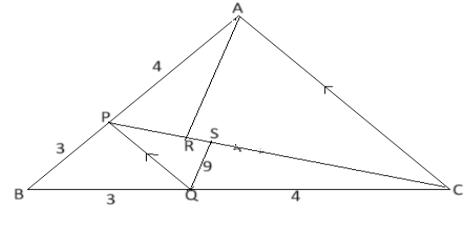Question
In AABC, P is a point on AB such that PB: AP = 3: 4 and
PQ is parallel to AC. If AR and QS are perpendicular to PC and QS = 9 cm, what is the length (in cm) of AR?Solution
 △ ABC with P on AB such that PB: AP = 3: 4. PQ || AC. AR ⊥ PC and QS ⊥ PC. QS = 9 cm. Proportional Segments: Given – PB: AP= 3: 4, let PB = 3k and AP = 4k. Therefore, AB = PB + AP=3k =4k = 7k. Similar Triangles: Since PQ || AC, triangles △ APQ and △ APC are similar. This implies the ratio of their corresponding sides is. PB/AB=3/7 Area of △PBQ/△ABC =9/49 Ratio of △APC and △QPC- =½ ×PC×AR: ½×PC×QS =AR: QS △APC/△QPC =AR/QS … (1) Area of △PBQ=9 and △QPC =12 Now Area of △APC =△ABC –(△PBQ+△QPC) =49-(9+12) =28. From Eq-(1) 28/12 =AR/9 AR =21cm.
△ ABC with P on AB such that PB: AP = 3: 4. PQ || AC. AR ⊥ PC and QS ⊥ PC. QS = 9 cm. Proportional Segments: Given – PB: AP= 3: 4, let PB = 3k and AP = 4k. Therefore, AB = PB + AP=3k =4k = 7k. Similar Triangles: Since PQ || AC, triangles △ APQ and △ APC are similar. This implies the ratio of their corresponding sides is. PB/AB=3/7 Area of △PBQ/△ABC =9/49 Ratio of △APC and △QPC- =½ ×PC×AR: ½×PC×QS =AR: QS △APC/△QPC =AR/QS … (1) Area of △PBQ=9 and △QPC =12 Now Area of △APC =△ABC –(△PBQ+△QPC) =49-(9+12) =28. From Eq-(1) 28/12 =AR/9 AR =21cm.
15.232 + 19.98% of 539.99 = ? × 8.99
647.1 ÷ ? + 72.3 × 209.81 – 8743.1 = 6404
(1560.23 ÷ 25.98) + (768.32 ÷ 23.9) + 1814.11 = ?
A train takes 8 seconds to pass a dog running in the opposite direction to the train at a speed of 10 m/s. Given that the train i...
? + 154.99 – 110.01 = 30.01 × 4.98
- What approximate value will come in place of the question mark (?) in the following question? (Note: You are not expected to calculate the exact value.)
(3.21) ? + 37.92 ÷ 1.98 = (5.99 + 3.99) 2
74.91% of 639.95 – 599.98% of 45 + 119.987 = ?
1459.98 ÷ 40.48 × 12.12 = ? × 3.16
What is the smallest integer that should be subtracted from 653 to make it divisible by both 23 and 27?
Relevant for Exams:


